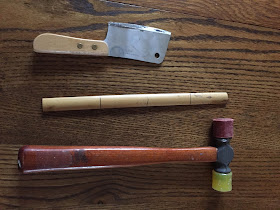CANE
SELECTION, PART 2
"The fundamental problem is still that of cane selection
to prevent subsequent failure."
~ Jean-Marie Heinrich, The Bassoon Reed
From Tube to Gouge
Finding the Straightest Section
Take a piece of gouged cane with the midpoint between the two ends drawn on the bark. Use this piece as a template for marking the section on the tube you want to cut out.
With a light source located behind the tube, roll the tube back and forth slowly on a flat, non-reflective surface. Look at the tube at table level and you will see light shining through under the ends of the tube where it warps away from the table.
 Roll the tube on the table to find
the position in which the tube has the most contact with the table. Above you
can see the left end of the tube is quite warped. This end can be cut off with
a scroll saw with a fine blade. Or you can mark this end with four marks at 90
degree points and cut off the warped ends in the gouger guillotine after
splitting.
Roll the tube on the table to find
the position in which the tube has the most contact with the table. Above you
can see the left end of the tube is quite warped. This end can be cut off with
a scroll saw with a fine blade. Or you can mark this end with four marks at 90
degree points and cut off the warped ends in the gouger guillotine after
splitting. Next position the marking piece by
the section of tube contacting the table, away from the warped end.
Next position the marking piece by
the section of tube contacting the table, away from the warped end.
Place the marking piece under the straight section of the tube.
 With a pencil or a permanent marker,
draw lines on the tube against both ends of the marking piece and against the
midpoint drawn on the piece.
With a pencil or a permanent marker,
draw lines on the tube against both ends of the marking piece and against the
midpoint drawn on the piece. 
Holding the marking piece in place on the tube, rotate the tube. Extend the marks completely around the circumference of the tube. The straightest section of the tube should be between the outer lines. Remove the marking piece.
Using a Radius Gauge
If you gouge cane yourself, you need to know the radius of your gouging bed. A mismatch between cane radius and gouger bed radius can result in asymmetrically gouged cane or even split cane.
I use the Fast Systems Radius Gage. It has cut-outs ranging from 24mm to 32mm in half millimeter increments. With its wide range of radii, it can be used by bassoonists, contrabassoonists and period instrument reed makers. Most bassoon players prefer cane diameters in the range of 24-25 mm, but you should prioritize for pieces of cane that match the diameter of your gouging bed.

The most important place for symmetry on the reed is at the fold because of its close proximity to the tip. While the section of tube cane marked out using the method above may be the straightest part of the tube, it's extremely important that the midpoint marked on the tube fit as closely as possible in the cutout that matches the gouger bed radius.
Place the tube in the cut out with the midpoint of the section sitting directly in the cut out. Rotate the tube to find the position at which little or no light shines through from behind. If it is impossible to find a good fit, try one of the adjacent cut-outs.
Marking the Cane for Splitting Having found the best cut out and best rotation for the tube, find the two white quarter circle reference marks on the cut out and mark their positions on the tube. These are the two white marks on either side of the millimeter number in each cut out.
Then sight down the tube at such an angle that you can see the white quarter circle marks on the gauge against the bark of the tube. Mark the two positions on the end grain of the tube that correspond to the position of the two white quadrant marks.
These marks will be where you will split out the piece from the tube.
Splitting the Cane
Do not use a cane splitter! The argument above should be enough to convince you that it's not possible to find straight pieces of cane simply by placing a splitter against the end grain and splitting.
Hold the tube upright on the table
and, using a small cleaver or broad knife, exert downward pressure with your
free hand or use a mallet to tap the blade into the tube. The blade will follow
the grain andsplit the section out without much effort.
This method takes about 2 minutes per section of cane.
More Usable Pieces?
It's very unlikely you'll get four symmetrical sections from one tube. However, it's often possible to find another symmetrical section with nearly the same radius just opposite from the section you've cut out on the tube.
You may also find larger or smaller diameter pieces usable for different instruments from one tube.







Hello Mr. Stees,
ReplyDeleteDo you know how I can find a Fast Systems radius gage for purchase? I have looked for a way to contact Mr. Fast directly but can’t seem to find one.
Best,
Robbie